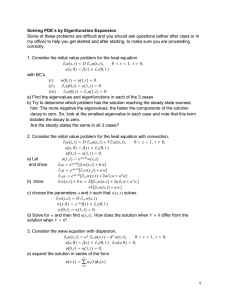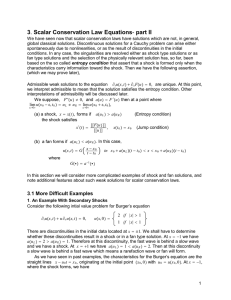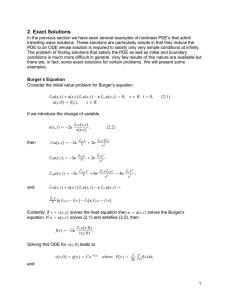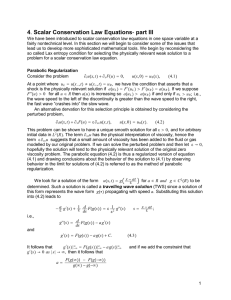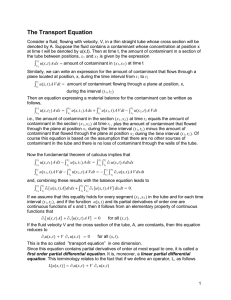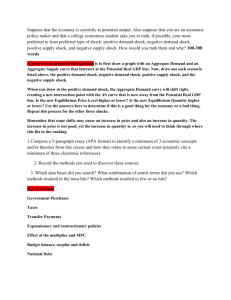2
advertisement
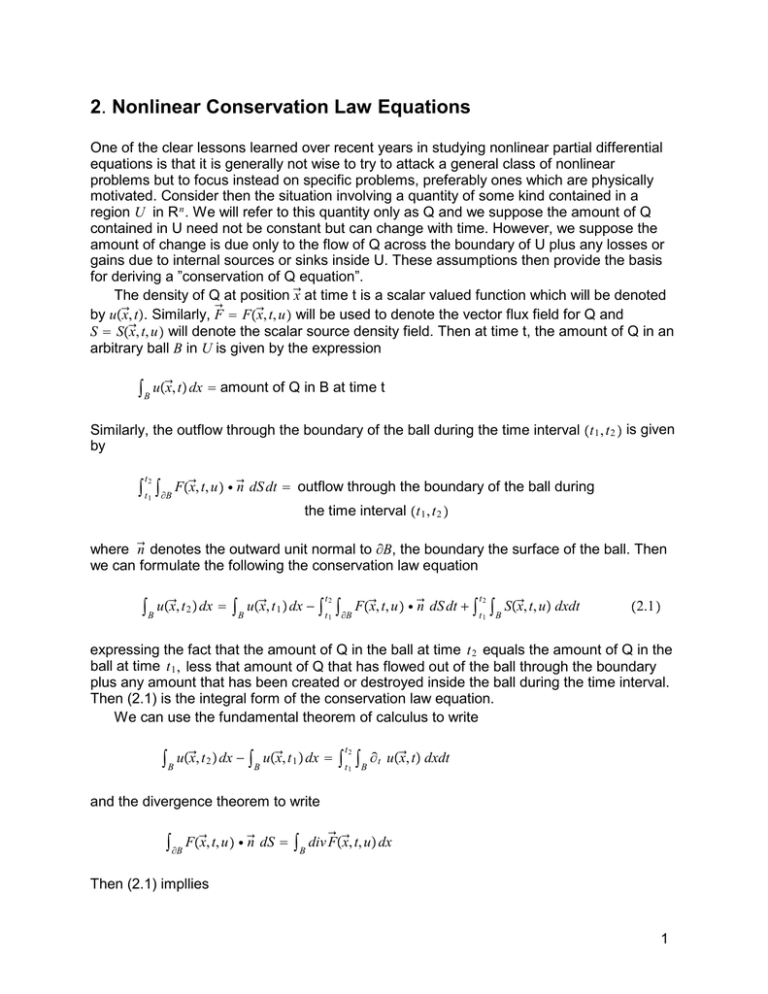
2. Nonlinear Conservation Law Equations One of the clear lessons learned over recent years in studying nonlinear partial differential equations is that it is generally not wise to try to attack a general class of nonlinear problems but to focus instead on specific problems, preferably ones which are physically motivated. Consider then the situation involving a quantity of some kind contained in a region U in R n . We will refer to this quantity only as Q and we suppose the amount of Q contained in U need not be constant but can change with time. However, we suppose the amount of change is due only to the flow of Q across the boundary of U plus any losses or gains due to internal sources or sinks inside U. These assumptions then provide the basis for deriving a ”conservation of Q equation”. The density of Q at position 3 x at time t is a scalar valued function which will be denoted 3 by uÝx3, tÞ. Similarly, F = FÝx3, t, uÞ will be used to denote the vector flux field for Q and S = SÝx3, t, uÞ will denote the scalar source density field. Then at time t, the amount of Q in an arbitrary ball B in U is given by the expression XB uÝx3, tÞ dx = amount of Q in B at time t Similarly, the outflow through the boundary of the ball during the time interval Ýt 1 , t 2 Þ is given by t X t 2 X/B FÝx3, t, uÞ 6 3n dS dt = outflow through the boundary of the ball during 1 the time interval Ýt 1 , t 2 Þ where 3 n denotes the outward unit normal to /B, the boundary the surface of the ball. Then we can formulate the following the conservation law equation t t XB uÝx3, t 2 Þ dx = XB uÝx3, t 1 Þ dx ? X t 2 X/B FÝx3, t, uÞ 6 3n dS dt + X t 2 XB SÝx3, t, uÞ dxdt 1 1 Ý2.1Þ expressing the fact that the amount of Q in the ball at time t 2 equals the amount of Q in the ball at time t 1 , less that amount of Q that has flowed out of the ball through the boundary plus any amount that has been created or destroyed inside the ball during the time interval. Then (2.1) is the integral form of the conservation law equation. We can use the fundamental theorem of calculus to write t XB uÝx3, t 2 Þ dx ? XB uÝx3, t 1 Þ dx = X t 2 XB / t uÝx3, tÞ dxdt 1 and the divergence theorem to write X/B FÝx3, t, uÞ 6 3n dS = XB div F3 Ýx3, t, uÞ dx Then (2.1) impllies 1 X t 2 XB ß / t uÝx3, tÞ + div F3 Ýx3, t, uÞ ? SÝx3, t, uÞà dx dt = 0. t 1 Since this must hold for every ball B contained in U, and every time interval Ýt 1 , t 2 Þ, it follows that if all of the functions here are assumed to be smooth then, 3 Ýx3, t, uÞ = SÝx3, t, uÞ / t uÝx3, tÞ + div F at all 3 x 5 U, and all t. 3 =F 3 ÝuÞ, then this becomes If we suppose that F / t uÝx3, tÞ + a 1 ÝuÞ / x 1 u + ... + a n ÝuÞ / x n u = SÝx3, t, uÞ at all 3 x 5 U, and all t. Ý2.2Þ where a j ÝuÞ = /F j , 1 ² j ² n. /u Equation (2.2) is the differential form of the conservation law. We refer to (2.2) as a scalar conservation law equation. Later we will consider problems where the unknown is a vector valued function. Then we will be faced with a system of equations of the form (2.2). Shock Type Solutions Equation (2.2) is a special case of a quasilinear first order pde and, as we have seen in the examples, such equations can have solutions with spontaneous singularities. Then since global classical solutions do not exist, in general, we must consider a weaker notion of solution. We will begin by considering the simplest example of equation (2.2). In the case of one space variable, n = 1 , the Cauchy problem for equation (2.2) with SÝuÞ = 0, reduces to / t uÝx, tÞ + / x FÝuÞ = 0, uÝx, 0Þ = u 0 ÝxÞ, x 5 R1, t > 0. Ý2.3Þ Let R 2+ = áx 5 R, t > 0â and R# 2+ = áx 5 R, t ³ 0â. Then a classical solution of (2.3) is a function in C 1 ÝR 2+ Þ V CÝR# 2+ Þ. As examples in the previous section have shown, it may be the case that no classical solution for (2.3) exists. 2 We will therefore define a weak solution for Ý2.3Þ, to mean a function u 5 L loc 1 ÝR + Þ, satisfying K X 0 XR ÝuÝx, tÞ / t dÝx, tÞ + FÝuÞ / x dÝx, tÞÞ dxdt + XR u 0 ÝxÞ dÝx, 0Þ dx = 0 -d 5 C Kc ÝR# 2+ Þ. Ý2.4Þ It is evident that (2.4) implies that u satisfies the equations of (2.3) in the sense of distributions. Then Ý2.4Þ and (2.3) have meaning in the distributional sense even when the function u is discontinuous. What is not evident is that these discontinuities in the solution are subject to some constraints. 2 Problem 2.1 Show that if u 5 L loc 1 ÝR + Þ satisfies (2.4) then u solves (2.3) in the sense of distributions, and if u 5 C 1 ÝR 2 Þ, satisfies (2.4), then u solves (2.3) in the classical sense. 2 Jump Conditions 2 Suppose uÝx, tÞ 5 L loc 1 ÝR + Þ is a weak solution for (2.3) such that u has a jump discontinuity across a curve C = Ýx, tÞ 5 R# 2+ : x = sÝtÞ . This means that u has (finite) one sided limits as C is approached from either side but at any point of C, the one sided limit from the left does not equal the one sided limit from the right. Let U denote an open set in R 2+ and suppose that C passes through U, dividing U into two disjoint parts, U 1 = U V áx < sÝtÞâ and U 2 = U V áx > sÝtÞâ. Note that a weak solution u, of (2.3) is a distributional solution of the pde in U. Suppose further, that u satisfies the pde in the classical pointwise sense in each of the sets U 1 and U 2 . / t uÝx, tÞ + / x FÝuÞ = ß/ t , / x à 6 Note that u = div FÝuÞ u FÝuÞ . In addition, for any d 5 C Kc ÝUÞ, du div u = d div d FÝuÞ /td + ßu, FÝuÞà 6 FÝuÞ /xd and for k = 1, 2, X XU div k du = XX d FÝuÞ Uk u d div + X X ßu, FÝuÞà 6 U FÝuÞ k /td /xd . Now the assumption that u satisfies the equation in (2.3) in the classical pointwise sense in U 1 and U 2 leads to u X XU d div FÝuÞ k = XX Uk dá/ t u + / x FÝuÞâ = 0 for k = 1, 2. Furthermore, (assuming that the distributional solution u is regular enough to permit the use of the divergence theorem) the divergence theorem gives X XU div k du d FÝuÞ =X /U k 3 nk 6 du d FÝuÞ . where 3 n k denotes the outer normal to /U k . Then X/U 3n k 6 k du d FÝuÞ . = X X ßu, FÝuÞà 6 U k /td /xd 3 and, by adding the equation with k = 1 to the equation with k = 2 we obtain du X/U 3n 1 6 .+X d FÝuÞ 1 /U 2 3 n2 6 du d FÝuÞ . = X X ßu, FÝuÞà 6 U /td /xd , Since u is a weak solution of (2.3) and d 5 C Kc ÝUÞ, the last integral on the right vanishes. Also, since supp d lies inside U it follows that d vanishes on /U. However the boundaries of the sets U k are not simply the two pieces of /U, but are composed of the curve C together with portions of /U. Then there is a part of /U k where d is not zero, namely on the discontinuity curve, C. It is important to note, however, that the orientation of C as part of the boundary of U 1 is opposite to the orientation of C when it is considered as part of the boundary of U 2 ; in particular this means, n# 1 = ?n# 2 . Then the last equation reduces to, XC VU 3n 1 6 1 du d FÝuÞ .?X 1 C VU 2 3 n1 6 du d FÝuÞ .=0 2 for all d 5 C Kc ÝUÞ. Here the subscripts 1 and 2 indicate that limiting values have been obtained by approaching C from within U 1 or U 2 . u(x,t) is discontinuous across C Now suppose the curve C along which u is discontinuous is given parametrically by, C: t = tÝsÞ x = xÝsÞ , . and as s varies from s = a to s = b, the part of the boundary of U 1 that lies on C is covered. 3 = ßx v ÝsÞ, ?t v ÝsÞà is easily Then the tangent to C can be written as 3 T = ßt v ÝsÞ, x v ÝsÞà, and, N seen to be normal to 3 T. The outward unit normal to C V U 1 is then 4 3 n 1 ÝsÞ = ßx v ÝsÞ, ?t v ÝsÞà (the parameter is scaled to make this a unit vector). This leads to b X a ßx v ÝsÞ, ?t v ÝsÞà 6 du d FÝuÞ du b ds ? X ßx v ÝsÞ, ?t v ÝsÞà 6 a ds = 0 d FÝuÞ 1 2 where du d FÝuÞ ÝpÞ = lim k q¸p q5U k du d FÝuÞ ÝqÞ = dÝqÞ uk FÝu k Þ . Then, b X a dÝsÞ áx v ÝsÞßu 1 ? u 2 à?t v ÝsÞßFÝu 1 Þ ? FÝu 2 Þàâ ds = 0 , where u 1 and u 2 denote respectively the left and right hand limiting values of u at points along C, the curve of discontinuities for uÝx, tÞ. Since this integral vanishes for all test functions d, we can conclude that t v ÝsÞßu 1 ? u 2 à?x v ÝsÞßFÝu 1 Þ ? FÝu 2 Þà = 0, or equivalently, dx = ßFÝu 1 Þ ? FÝu 2 Þà = ßßFÝuÞàà dt ßu 1 ? u 2 à ßßuàà Ý2.5Þ where we use the notation ßßuàà to denote the jump in the value of u as the curve C is crossed from left to right. Note that x v ÝtÞ = a is equal to the speed with which the curve C propagates. Then (2.5) asserts that ßßFÝuÞàà = aßßuàà, and this is referred to as the Rankine-Hugoniot relation for the conservation law (2.3). A solution for (2.3) which is discontinuous across a curve C but is smooth on either side of the curve and in addition satisfies (2.5), is referred to as a shock type solution for the conservation law. The curve C is called a shock curve. The Rankine-Hugoniot relation asserts that discontinuities in the solution to a conservation law do not propagate along arbitrary curves but can be consistent with the conservation law only when they propagate along curves which are solution curves for (2.5). Note that if FÝuÞ = aÝx, tÞ uÝx, tÞ, then the conservation law is a linear pde and (2.5) reduces to x v ÝtÞ = aÝx, tÞ; i.e., the shock curve C is just a base characteristic for the linear pde. The conservation law is said to be genuinely nonlinear if F ”ÝuÞ ® 0. (i.e, if FÝuÞ = aÝx, tÞ uÝx, tÞ then F v ÝuÞ = aÝx, tÞ, and F ”ÝuÞ = 0 ). When the equation is genuinely nonlinear, the shocks are not base characteristics. Example 2.1 1. Consider the Cauchy problem / t uÝx, tÞ + uÝx, tÞ / x uÝx, tÞ = 0, uÝx, 0Þ = 1 if x < 0 0 if x > 0 Here, the initial condition has a jump discontinuity at x = 0 hence we expect a solution which is a weak solution having a jump discontinuity across a curve C which originates at 5 the point Ý0, 0Þ. Of course this curve will then have to conform to the Rankine-Hugeniot conditions. Note that uÝx, tÞ / x uÝx, tÞ = / x 12 u 2 Ýx, tÞ = / x FÝuÞ. This equation is known as Burger’s equation and in this case, we have ßßuàà = u 1 ? u 2 = 1 ? 0, and Then 1 2 ßßFÝuÞàà = ßßuàà ßßFÝuÞàà = FÝu 1 Þ ? FÝu 2 Þ = u 21 ? 12 u 22 = u1 ? u2 1 2 Ýu 1 + u 2 Þ = 1 2 1 2 u 21 ? 1 2 u 22 . Ý1 + 0Þ, and the Rankine-Hugeniot conditions imply that the shock curve is a solution curve for x v ÝtÞ = 1/2. Since the discontinuity is located at x = 0 when t = 0, we have the initial condition, xÝ0Þ = 0; i.e., xÝtÞ = t/2. Then the shock curve is the straight line xÝtÞ = t/2, and the shock solution for this initial value problem is the discontinuous function, uÝx, tÞ = x < t/2 1 if 0 if x > t/2 t ³ 0. Of course since the solution is discontinuous, this is only a solution in the weak sense. 2. Now consider the Cauchy problem / t uÝx, tÞ + uÝx, tÞ / x uÝx, tÞ = 0, uÝx, 0Þ = 0 if x < 0 1 if x > 0 As in the previous example, we can show that xÝtÞ = t/2 is a shock curve for this problem and a shock solution is given by the discontinuous function u 1 Ýx, tÞ = 0 if x < t/2 1 if x > t/2 t ³ 0. On the other hand, it is easy to check that the continuous function u 2 Ýx, tÞ = 0 x t 1 if x < 0 if 0 < x < t, t³0 if x > t is also a solution to the initial value problem. This continuous solution is an example of what is called an ”expansion fan solution”. We shall have to appeal to physical principles in order to decide which (if either is) is the physically relevant solution to the problem. 3.The previous example provided our first encounter with loss of uniqueness. We consider now a more extreme case of lack of uniqueness. Suppose uÝx, tÞ solves, 6 / t uÝx, tÞ + uÝx, tÞ / x uÝx, tÞ = 0, uÝx, 0Þ = ?1 if x < 0 1 if x > 0 We can show that this problem has an infinite family of shock type solutions and, in addition, it has one expansion fan solution. We do not yet have any way of selecting ”the correct” solution out of this collection. Since the initial condition here is discontinuous at x = 0, if a shock type solution exists, it must originate at x = 0, t = 0. In fact, there are an infinite number of shocks that could originate from this point. For each choice of a parameter, a, 0 < a < 1, there are three shocks originating at Ý0, 0Þ, all of which satisfy the R-K condition. For an arbitrary a, 0 < a < 1, the corresponding shock type solutions for the pde are given by ?1 if x < ?t uÝx, tÞ = a 1?a 2 if ?t 1?a < x < 0, t > 0 2 ?a if 0 < x < t 1 , t>0 if t 1?a 2 1?a 2 , t>0 < x, t > 0 The first shock, S1, separates the region where u = ?1 from a region where u = a hence it satisfies, x v ÝtÞ = 1 2 Ýu 1 + u 2 Þ = 1 2 Ý?1 + aÞ, xÝ0Þ = 0; i.e., x 1 ÝtÞ = ?t 1?a 2 . The second shock, S2, separates the region where u = a from a region where u = ?a hence this shock satisfies, x v ÝtÞ = 1 2 Ýu 1 + u 2 Þ = 1 2 Ýa ? aÞ = 0, xÝ0Þ = 0; i.e., x 2 ÝtÞ = 0. Finally the last shock, S3, separates the region where u = ?a from a region where u = 1 so it must satisfy, x v ÝtÞ = 1 2 Ýu 1 + u 2 Þ = 1 2 Ý?a + 1Þ, xÝ0Þ = 0; i.e., x 3 ÝtÞ = t 1?a 2 Since this locally constant function satisfies the pde in the distributional sense, and since each of the discontinuity lines satisfies the R-H conditions, this is a mathematically acceptable shock type solution for the Cauchy problem. Visually, the solution can be represented as follows: 7 A 3 Shock Solution In addition to the shock solution, this problem has another solution of the expansion fan type. The following, continuous and piecewise differentiable function can be shown to solve the Cauchy problem uÝx, tÞ = ?1 if x < ?t, t > 0 x if ?t < x < t, t > 0 t 1 if x > t, t > 0 This solution looks as follows, A Fan Type Solution We shall have to await the development of selection principles to determine which of these solutions is the physically correct one. 4. Consider the Cauchy problem 1 / t uÝx, tÞ + uÝx, tÞ / x uÝx, tÞ = 0, uÝx, 0Þ = fÝxÞ = if x < 0 1 ? x if 0 < x < 1 0 if x > 1 Here the initial condition is continuous so we expect a non-shock weak solution for the initial value problem, and we will use the method of characteristics to construct this solution. Since the pde is homogeneous, the solution is constant along characteristics. Then the coefficient in the equation, u = uÝx, tÞ, is constant on each characteristic (although it is not 8 necessarily the same constant on each characteristic). This leads to the result that the characteristics are straight lines. The equation for the base characteristics is x v ÝtÞ = uÝtÞ, and it follows that x ? u 0 t = x 0 is the equation for the characteristic originating at the point Ýx 0 , 0Þ, where u 0 = fÝx 0 Þ. There are three cases to consider. ¾ If x 0 ² 0 then u 0 = fÝx 0 Þ = 1, hence the characteristics that originate on the left half line át < 0â are given by x ? t = x 0 and the solution is given by uÝx, tÞ = 1 if x ? t < 0. ¾ If x 0 ³ 1 then u 0 = fÝx 0 Þ = 0, and the characteristics that originate on the half line át > 1â are given by x = x 0 . Then the solution is given by uÝx, tÞ = 0 if x > 1, t > 0. ¾ If 0 ² x 0 ² 1 then u 0 = fÝx 0 Þ, and the solution is given by u = fÝx ? utÞ = 1 ? Ýx ? utÞ. Solving this equation for u in terms of x and t leads to, uÝx, tÞ = 1 ? x , 1?t for t < x < 1, 0 < t < 1. Note that at t = 1, the value u = 1 carried along the characteristic x = t, collides with the value u = 0 being carried along the characteristic, x = 1 (not to mention the values u p = Ý1 ? x p Þ that move along the lines x ? u p t = x p , which all collide at the point Ý1, 1Þ). Although the solution to the pde is continuous up to the time t = 1, at the point, t = 1, x = 1, a discontinuity appears and the classical solution no longer exists. For t > 1 the solution must be a weak solution originating from a discontinuous initial condition at t = 1; i.e., / t uÝx, tÞ + uÝx, tÞ / x uÝx, tÞ = 0, uÝx, 1Þ = 1 if x < 1 0 if x > 1 In the same way we did in the first example, then we find the shock curve is the straight line,x ? t/2 = 1, t > 1, and a weak solution is provided by a function which is constant on either side of the shock curve, u 2 Ýx, tÞ = 1 if x < Ý1 + tÞ/2 0 if x > Ý1 + tÞ/2 t ³ 1, Then u 2 is the weak solution of the initial value problem originating at t = 1, and a complete weak solution to the original problem is given by uÝx, tÞ = 1 1?x 1?t 0 if x < t, if t < x < 1, 0 < t < 1 if x > 1, 1 if x < Ý1 + tÞ/2, 0 if x > Ý1 + tÞ/2, t>1 All we know at this point is that this is the only possible shock type solution for this problem. 9 Selection Principles We will describe now the simplest of the so called selection principles by means of which we can choose the physically relevant solution from the collection of all possible solutions to a nonlinear conservation law equation. The principle can be stated as the condition that a shock can exist only if the nearby characteristics carry information toward the shock not away from the shock. This is consistent with the examples we have seen in which the shock occurs when characteristics carrying conflicting values collide. When characteristics carrying conflicting information diverge from one another, leaving an empty wedge containing no characteristics, a shock solution can be constructed but this solution is nonphysical in the sense that it violates the principle of causality and, in the context of gas dynamics, the solution can be shown to produce a decrease in entropy across the shock, violating the second law of thermodynamics. For this reason, the condition we are about to discuss is called the entropy condition. Other selection principles leading to the same results will be given later. If the equation is given by / t uÝx, tÞ + / x FÝuÞ = / t uÝx, tÞ + aÝuÞ / x u = 0, then the entropy condition takes the form, Recalling earlier experiences with the linear transport equation, we can view aÝuÞ = F v ÝuÞ as the wave speed in a transport equation. Then the condition of admissibility for a shock solution is that the wave behind the shock travels faster than the wave ahead of the shock; i.e., the shock results when a fast moving wave runs up the back of a slow moving wave. On the other hand, if the slow moving wave is behind the faster wave, then the fast wave just pulls away from the slower wave. In this case no shock develops but instead we have a fan type solution. Applying the selection principle to example 4, we observe the following: 1st shock, S1- F v Ýu 1 Þ = ?1 < x v ÝtÞ = 1 2 Ý?1 + aÞ < a = F v Ýu 2 Þ 2nd shock, S2- F v Ýu 1 Þ = a < x v ÝtÞ = 0 < ?a = F v Ýu 2 Þ 3rd shock, S3- F v Ýu 1 Þ = ?a < x v ÝtÞ = 1 2 Ýcondition not satisfiedÞ Ýcondition is satisfiedÞ Ý1 ? aÞ < 1 = F v Ýu 2 Þ Ýcondition not satisfiedÞ 10 Then this shock solution, while mathematically correct, fails to satisfy the selection condition and it is therefore not a physically relevant solution. The fan type solution is therefore the one that is physically relevant. Expansion Fans Expansion fans are also called rarefaction wave solutions as they represent the physical situation where a fast wave runs away from slower trailing waves, leaving an area of rarefaction in between. In order to motivate this type of solution, consider the following example for some L > 0, 0 / t uÝx, tÞ + uÝx, tÞ / x uÝx, tÞ = 0, uÝx, 0Þ = fÝxÞ = if x < 0 x/L if 0 < x < L 1 if x > L As we have seen in previous examples, the base characteristics are given by x ? u 0 t = x 0 ; i.e., this is the equation of the characteristic originating at Ýx 0 , 0Þ where uÝx 0 , 0Þ = u 0 . Now there are three cases to consider, if x 0 < 0 then u 0 = 0 so x = x 0 for all characteristics that originate to the left of zero if x 0 > L then u 0 = 1 so x = t + x 0 for all characteristics that originate to the right of x = L if 0 < x 0 < L, then uÝx, tÞ = fÝx ? utÞ and uÝx 0 , 0Þ = x 0 /L = fÝx 0 Þ so uÝx, tÞ = x ? ut L This third case leads to the solution uÝx, tÞ = x L+t 0 < x < L + t, t > 0. Continuous solution for L > 0 11 Letting L tend to zero causes this picture to become L=0, Rarefaction Wave Solution i.e., 0 uÝx, tÞ = x L+t 1 if x < 0 if 0 < x < L + t, t > 0 ì if x > L + t, t > 0 0 x t 1 if x < 0 if 0 < x < t, t > 0 if x > t, t > 0 This last solution is the rarefaction wave solution. To further motivate the expansion fan solution, consider the initial value problem / t uÝx, tÞ + / x FÝuÞ = 0, uÝx, 0Þ = u L if x < x 0 u R if x > x 0 where we suppose F”ÝuÞ ® 0, aÝuÞ = F v ÝuÞ and u L < u R so the equation is genuinely nonlinear and the shock solution is not admissible. The characteristics in this case are, i) x ? aÝu L Þ t = x p if x p < x 0 and u = u L for x < x 0 + aÝu L Þ t, t > 0 ii) x ? aÝu R Þ t = x p if x p > x 0 and u = u R for x < x 0 + aÝu L Þ t, t > 0 Since u L < u R , there are no characteristics in the wedge, aÝu L Þ t < x ? x 0 < aÝu R Þ t 12 Note that the family of rays, x ? x 0 = V, fill the wedge as V varies over the interval, t ßaÝu L Þ < V < aÝu R Þà. This suggests that we try a solution of the form, uÝx, tÞ = G x ? x 0 t the wedge. This leads to, / t uÝx, tÞ = G v x ? x 0 t and ? x ?2x 0 t ® 0, then / x uÝx, tÞ = G v x ? x 0 t ? x ?2x 0 + a G x ? x 0 t t / t uÝx, tÞ + / x FÝuÞ = G v x ? x 0 t If G v x ? x 0 t , a G x ? x0 t in 1 , t 1 t = 0. = x ? x0 ; t Since F”ÝuÞ > 0, F v ÝuÞ = aÝuÞ is invertible, and it follows that GÝ6Þ = ßaÝ6Þà ?1 . Then the following is a solution of the pde in all three regions of the half plane, uL uÝx, tÞ = G x ? x0 t uR if x < aÝu L Þt + x 0 if aÝu L Þ t < x ? x 0 < aÝu R Þ t if x > aÝu L Þt + x 0 and, in addition, the solution is continuous (but not differentiable) across the boundaries of the wedge; i.e., uÝaÝu p Þt + x 0 , tÞ = G x ? x 0 t = GÝaÝu p ÞÞ = u p , p = L, R. In the case of Burger’s equation, FvÝuÞ = aÝuÞ = u ÝidentityÞ, so we have G = ÝaÞ ?1 = identity, GÝuÞ = u. 13
